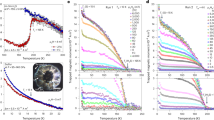Abstract
In a famous experiment, a magnet is levitated above a superconductor that has been cooled to 77 K in liquid nitrogen. Here we show that in this set-up, liquid oxygen drops form on the superconductor, drip upwards, hit the magnet and then boil.
Similar content being viewed by others
Main
In this arrangement, oxygen (which boils at 92 K) condenses out of the air into the liquid nitrogen. Liquid oxygen is sufficiently paramagnetic that it can be pulled into the high-field region between the magnet and the superconductor to form a bridge (Fig. 1).
When a strong neodymium–iron–boron magnet is levitated above a YBa2Cu3O7 superconductor, the bulk and surface-screening supercurrents provide both buoyancy and a restoring force on the magnet. The bulk supercurrents are produced by the penetration of the magnetic field into the superconductor in the form of quantized flux lines that are pinned by defects and impurities in the material.
Large drops of liquid oxygen can bridge the gap between the magnet and the superconductor. Small drops can instigate a continuous process in which a new drop begins to form on the superconductor after an old one has been pulled across the gap onto the magnet and boiled away.
An advantageous feature of this demonstration is that it does not require the handling of liquid oxygen. For further details and a demonstration of the superconductivity, magnetism and thermodynamics in action, see http://www.dur.ac.uk/d.p.hampshire/drop.html.
Author information
Authors and Affiliations
Corresponding author
Rights and permissions
About this article
Cite this article
Wood, D., Greener, V. & Hampshire, D. Oxygen drips upwards from superconductors. Nature 415, 860 (2002). https://doi.org/10.1038/415860a
Issue Date:
DOI: https://doi.org/10.1038/415860a
Comments
By submitting a comment you agree to abide by our Terms and Community Guidelines. If you find something abusive or that does not comply with our terms or guidelines please flag it as inappropriate.




